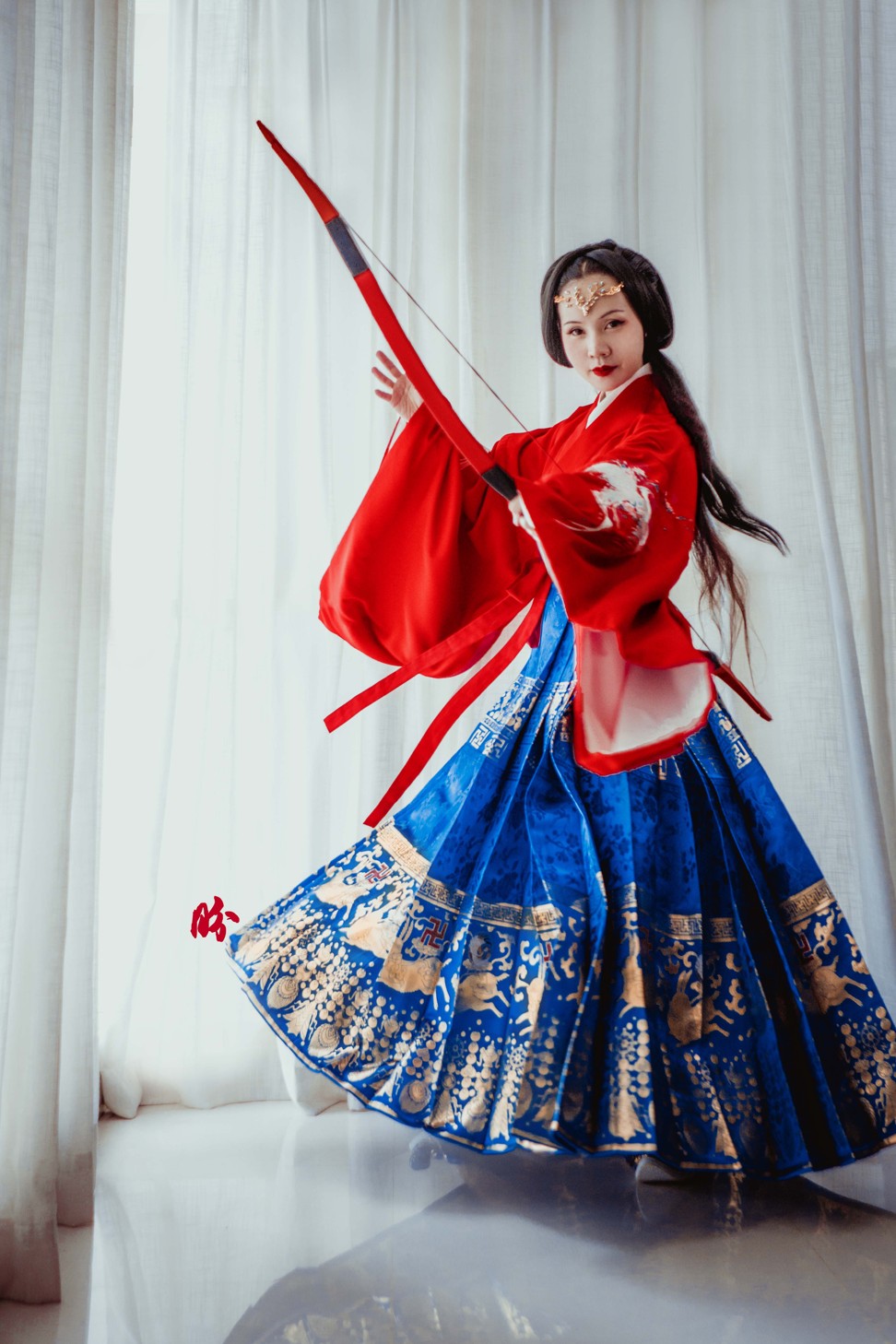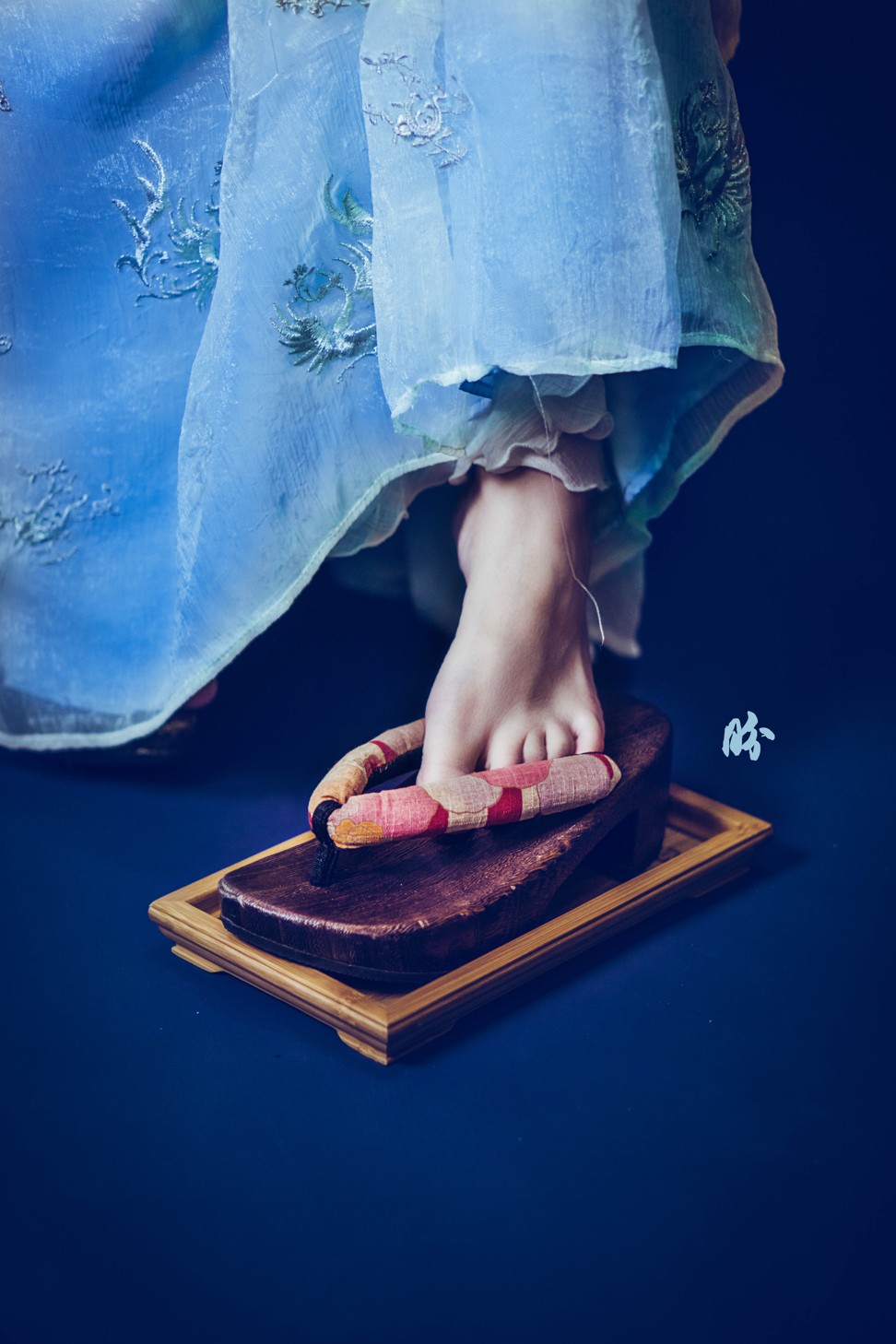
We’re not weak, we’re Wonder Women: real Chinese femininity celebrated by group fighting traditional stereotypes through ancient dress and customs
- A group of Singaporean women are subverting stereotypes of Chinese femininity by portraying Chinese beauty as not all about being demure and fairy-like
- Called the Hanfugirls Collective, they use traditional dress and customs to express themselves as empowered, modern, confident women of Chinese heritage
Gong Pan Pan wears a vivid blue dress and a red overcoat harking back through centuries of Chinese history. Her powdered face is fierce and her forehead is adorned with an elaborate deer ornament. She wears a heavy archer’s ring on her thumb as she lifts her bow and reaches for an arrow from the quiver on her back.
Despite being born into a largely male-dominated society, Lady Hao was a formidable military general, an empress and a high priestess who conducted oracle bone reading ceremonies. To Gong, Lady Hao stands as a symbol of female empowerment.

Gong is one of a group of about 30 Singaporean women fighting to subvert traditional stereotypes of Chinese femininity, challenge male assumptions and celebrate their Chinese heritage.

In their 20s and 30s, the Hanfugirls hail from diverse backgrounds. There are mothers, marketers, stylists, professional dancers and musicians, and a doctoral researcher.
“An archetypal Chinese feminine beauty is demure and virginal,” says Gong, who works at a local museum. “The image we want to portray is that we are not weak, submissive or waiting to be rescued. It’s really about expressing ourselves so we feel more empowered as modern, confident women of Chinese heritage.”

The collective’s founder, Gong had her first brush with this recreational subculture in 2015, when she and her husband flew to Beijing for a photo shoot themed on ancient China. Intrigued, Gong trawled through forums and borrowed books to learn more about Chinese history. Having moved from China to Singapore at the age of seven, she says it was a way of getting in touch with her Chinese roots.
“That’s when I realised history is not that boring,” she says. “Every item has a story behind it. Men’s way of telling history is through war, armour, tactics. But you can also tell stories through dresses, textiles, make-up and accessories.”

Contrary to the popular belief that Chinese society was always patriarchal, Gong wanted to prove that women in ancient times had their own power.
The title of her “Hanfugirl Disney Edition” photo series, which took two years to produce, is a nod to the power of imagery and pop culture.

Gong also focused on Xi Shi, another of the famed “Four Beauties” of ancient China. Born in a mountain village where her father was a firewood vendor and her mother a weaver, her feet were said to be large because she grew up working as a labourer. She wore wooden clogs instead of dainty embroidered shoes.
Sent as a spy to seduce the King of Wu, skilled dancer Xi wore small bells fastened to her waist. The king built a long hallway laid over with wooden planks especially for her to dance.
The collective is keen to steer away from China’s xian nu (fairy deity) image, which typically features beautiful, celestial-looking women with long flowing hair.

In the Hanfu girls’ photoshoots, dramatic, unconventional styles take centre stage. These include the “outrageous” make-up of the Tang dynasty, such as exaggerated frowning eyebrows (sometimes green), yellow powder or painted flowers on the forehead, tiny cherry-red lips, spots of red on the cheekbones, and fancy decorations made from gold foil, insect wings and feathers pasted on their faces. Tang women might also paint a red crescent shape on their temples, or a mark resembling a wound or scar. Sometimes, they cross-dressed.[
Gong owns more than 20 silk outfits and 50 others bought from online shopping site Taobao, ranging from Han dynasty (206BC-AD220) styles to costumes from the 1920s and 1930s. She estimates the collection is worth S$20,000 (US$14,000).
She liaises with suppliers and craftsmen who create the handmade heritage jewellery pieces for popular Chinese television dramas including Story of Yanxi Palace . Her collection includes replica accessories of silver and gold filigree with cloisonné decorations and period-specific brocade shoes.

“We feel that Chinese culture is very different from what we understand growing up,” Gong says. “It’s a very misunderstood, underrated culture. We always take it at face value, that Chinese culture is about dances with fans and ribbons, or banquet songs or shopping centre shows that play Lunar New Year songs.”
In 2018, Gong posted an open call to find women interested in helping her with modelling, research and content creation, because each of her projects can take from two weeks to two years.
“I didn’t want just pretty girls who want to dress up and look good for the ’gram [Instagram],” she says. “The world has no lack of pretty girls. We just need more content, research and more empowered women.”

Madeline Xiong, 31, who chanced upon Gong’s blog, says joining the collective was a dream come true.
“I never knew such a group existed. In the past, I would just watch a lot of shows, read up about the history, and even find out what inspired the architecture of the Forbidden City. I couldn’t find anyone with similar interests, so it became a closet hobby to me,” says Xiong, who works at a camera rental shop and now tries to incorporate hanfu in everyday dressing with a brooch or hairpin.
She believes women can be their own agents of change. “A lot of the characters we portray come from poor or troubled backgrounds, but we can break out of it. We can shape our own destiny.”

Describing the research process as “intensive”, Xiong likens it to preparing for a final-year thesis, explaining that the group checks academic and research papers from universities to ensure their information is as accurate as possible.
The team is also gearing up to perform at a first ever courtesans’ night set in a Tang-era entertainment house at the Stamford Arts Centre in August. In the immersive theatre experience, guests will be treated to a tea ceremony, poetry games and riddles, as well as ancient dance with live music performances by the Hanfugirls in collaboration with professional Chinese musicians and dancers.

Gong says Chinese courtesans were extremely talented women who were on equal terms with men and consorted with emperors and prime ministers. Accomplished artists in their own right, they inspired the poets of the day.
Another member, Leong Hui Min, 26, who works in the private sector, describes the Hanfugirls Collective as a “sisterhood”, where women can share their views about female issues in a safe space and redefine historical narratives. To her, the collective is more than just cosplay.
Member Chong Lingying, who works at a local publishing house, says friends who see the Hanfugirls’ photos start to see history in a different way. “In fact, a lot of my friends would like to be hanfu boys.”

